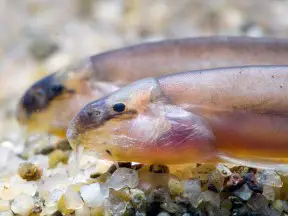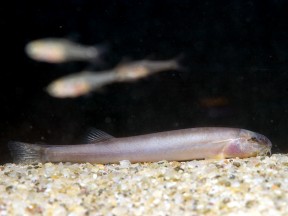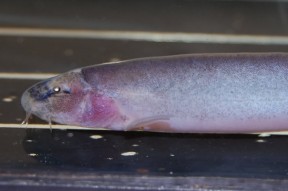Lepidocephalus macrochir
SynonymsTop ↑
Cobitis macrochir Bleeker, 1854; Lepidocephalichthys pallens Vaillant, 1902; Acanthophthalmus pahangensis de Beaufort, 1933
Etymology
Lepidocephalus: from the Greek lepis, meaning ‘scale’, and kephalus, meaning ‘head’.
Classification
Order: Cypriniformes Family: Cobitidae
Distribution
The distribution records for this species are somewhat confusing.
It was described from the Lamatang and Enim rivers, Palambang Province, Sumatra and has since been recorded from Thailand (Chao Phraya River), Peninsular Malaysia (Pahang River) plus the islands of Java (Solo River) and Borneo (Kapuas and Barito rivers).
The full type locality is ‘Confluence of Lamatang and Enim rivers, Palembang, eastern Sumatra; Pepeh River, Surakarta, central Java, Indonesia’.
Habitat
Little information is available. Although sometimes said to be a cave loach Thai collectors have reported it to inhabit deep water and that it can only be caught during periods of extreme low water.
Under the latter scenario one would therefore expect it to be found in major river channels with aquarium behaviour suggesting it spends a lot of time buried in soft substrates.
Maximum Standard Length
80 – 90 mm.
Aquarium SizeTop ↑
Base dimensions of 75 ∗ 30 cm or more are required.
Maintenance
Must be provided with a soft, sandy substrate since some of its time is spent completely buried. When coarser gravel is used it may become stressed or damage itself trying to dig, and feeding behaviour can be inhibited.
Other décor can include water-worn rocks and driftwood branches and tree roots arranged to form plenty of hiding places and shaded spots – add these prior to the substrate to prevent them being toppled by digging activity.
Lighting can be quite dim unless you intend to grow plants and a few handfuls of leaf litter would complement the natural effect.
High flow rates are best avoided although a degree of oxygenation is recommended. Ensure that small specimens are unable to enter filter intakes and cover the tank well as most loaches do jump at times, especially when first introduced.
Water Conditions
Temperature: 22 – 26 °C
pH: 5.5 – 7.5
Hardness: 36 – 179 ppm
Diet
Probably a micropredator feeding on insect larvae, small crustaceans and suchlike in nature.
In the aquarium it will accept sinking dried foods but should also be offered regular meals of small live and frozen fare such as Daphnia, Artemia, bloodworm, etc.
Behaviour and CompatibilityTop ↑
Peaceful both with conspecifics and other fishes and there exist no reports of it harming tankmates though it may prey on eggs or fry.
It fares best in the presence of conspecifics and should ideally be kept in a group of 4 or more specimens.
It’s a naturally shy species and therefore will easily be outcompeted for food if maintained alongside aggressive feeders such as most members of the families Botiidae and Nemacheilidae.
Better choices include Pangio, Acanthopsoides and Kottelatlimia spp., small cyprinids such as Trigonostigma, Boraras or smaller Danio spp. and anabantoids like Trichopsis pumila.
Sexual Dimorphism
The second pectoral-fin ray is extended in sexually mature males while females are likely to be deeper-bodied, especially when full of eggs.
Reproduction
Unreported in captivity.
NotesTop ↑
This species is only available in the aquarium trade sporadically and tends to be expensive. It’s traded under various names including ‘pinky loach’, ‘deep water kuhli loach’ and ‘Borneo high body cave loach’.
There are currently just two species in the genus with the other, L. spectrum, endemic to Borneo and lacking eyes entirely.
Lepidocephalichthys thermalis was for a number of years considered to fall within the grouping but confirmation of its correct placement was provided by Havird and Page (2010).
The family Cobitidae, often referred to as ‘true’ loaches, is widely-distributed across most of Eurasia with the Indian subcontinent, Southeast Asia and China representing particular centres of species diversity.
Phylogenetic analyses by Tang et al. (2006), Šlechtová et al. (2007) and Šlechtová et al. (2008) revealed that the group constitutes a separate genetic lineage to the family Botiidae (the two were previously grouped together under Cobitidae as subfamilies Cobitinae and Botiinae).
In the most recent study Lepidocephalichthys was not found to be as closely-related to Pangio, Lepidocephalus or Kottelatlimia as previously hypothesised though unfortunately the authors stop short of proposing an alternative theory.
All cobitids possess sharp, motile, sub-ocular spines which are normally concealed within a pouch of skin but erected when an individual is stressed, e.g. if removed from the water. Care is therefore necessary as these can become entangled in aquarium nets and with larger species even break human skin.
References
- Bleeker, P., 1854 - Natuurkundig Tijdschrift voor Nederlandsch Indië 7: 49-108
Overzigt der ichthyologische fauna van Sumatra, met beschrijving van eenige nieuwe soorten. - de Beaufort, L. F., 1933 - Bulletin of the Raffles Museum 8: 31-36
On some new or rare species of Ostariophysi from the Malay Peninsula and a new species of Betta from Borneo. - Kottelat, M., 2012 - Raffles Bulletin of Zoology Supplement 26: 1-199
Conspectus cobitidum: an inventory of the loaches of the world (Teleostei: Cypriniformes: Cobitoidei). - Roberts, T. R., 1989 - Memoirs of the California Academy of Sciences 14: i-xii + 1-210
The freshwater fishes of western Borneo (Kalimantan Barat, Indonesia). - Tang, Q., H. Liu, R. Mayden and B. Xiong, 2006 - Molecular Phylogenetics and Evolution 39(2): 347-357
Comparison of evolutionary rates in the mitochondrial DNA cytochrome b gene and control region and their implications for phylogeny of the Cobitoidea (Teleostei: Cypriniformes). - Vaillant, L. L., 1902 - Notes from the Leyden Museum 24(1): 1-166
Résultats zoologiques de l'expédition scientifique Néerlandaise au Bornéo central. Poissons. - Šlechtová, V., J. Bohlen and A. Perdices, 2008 - Molecular Phylogenetics and Evolution 47(2): 812-831
Molecular phylogeny of the freshwater fish family Cobitidae (Cypriniformes: Teleostei): delimitation of genera, mitochondrial introgression and evolution of sexual dimorphism. - Šlechtová, V., J. Bohlen and H. H. Tan, 2007 - Molecular Phylogenetics and Evolution 44(3): 1358-1365
Families of Cobitoidea (Teleostei; Cypriniformes) as revealed from nuclear genetic data and the position of the mysterious genera Barbucca, Psilorhynchus, Serpenticobitis and Vaillantella.






